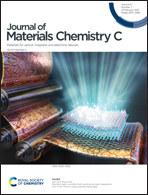Anisotropic ionic transport-controlled synaptic weight update by protonation in a VO2 transistor†
Abstract
Ionic–electronic coupling in a lattice strongly influences the memory and learning process by synaptic weight update in electrochemical synaptic transistors. In particular, anisotropic crystal symmetry offers a highly anisotropic diffusion process, which leads to facilitated ion migration and efficient coupling in synaptic devices. Here, we report all-solid-state VO2 synaptic transistors in which the proton diffusion under gate bias can be tuned by utilizing different crystal facets in anisotropic VO2 channels. Synaptic weight update (i.e., excitatory post-synaptic current) by a proton (H+) in the VO2 channel was sensitively tuned depending on the empty tunnel alignment of VO2 layers. By emulating synaptic functions using diffusion-pathway-controlled transistors, the alignment of a facile ionic pathway with gating direction increases the retention of H+ in VO2 lattices by locating H+ into the deep regions from the interfaces, and thus strengthens long-term memory in artificial synaptic devices. These results demonstrate that the control of field-driven ionic redistribution guided by crystal anisotropy provides an opportunity to manipulate the learning and forgetting behavior in artificial synaptic devices.



 Please wait while we load your content...
Please wait while we load your content...